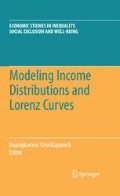Abstract
Modelling Lorenz curves (LC) for stochastic dominance comparisons is central to the analysis of income distributions. It is conventional to use non-parametric statistics based on empirical income cumulants which are used in the construction of LC and other related second-order dominance criteria. However, although attractive because of its simplicity and its apparent flexibility, this approach suffers from important drawbacks. While no assumptions need to be made regarding the data-generating process (income distribution model), the empirical LC can be very sensitive to data particularities, especially in the upper tail of the distribution. This robustness problem can lead in practice to “wrong” interpretation of dominance orders. A possible remedy for this problem is the use of parametric or semi-parametric models for the data-generating process and robust estimators to obtain parameter estimates. In this paper, we focus on the robust estimation of semi-parametric LC and investigate issues such as sensitivity of LC estimators to data contamination (Cowell and Victoria-Feser, 2002), trimmed LC (Cowell and Victoria-Feser, 2006), and inference for trimmed LC (Cowell and Victoria-Feser, 2003), robust semi-parametric estimation for LC (Cowell and Victoria-Feser, 2007), selection of optimal thresholds for (robust) semi-parametric modelling (Dupuis and Victoria-Feser, 2006), and use both simulations and real data to illustrate these points.
Access this chapter
Tax calculation will be finalised at checkout
Purchases are for personal use only
Preview
Unable to display preview. Download preview PDF.
References
Atkinson, A. B. (2004) Income tax and Top Incomes over the Twentieth Century, Hacienda P ública Española, 168, 123-141.
Beirlant, J., P. Vynckier and J. L. Teugels (1996) Tail Index Estimation, Pareto Quantile Plots, and Regression Diagnistics, Journal of the American Statistical Association, 91, 1651-1667.
Cowell, F. A. (2007) Inequality: Measurement, in L. Blume and S. Durlauf (eds.) The New Palgrave, Palgrave Macmillan, Basingstoke, Hampshire, UK.
Cowell, F. A. and M.-P. Victoria-Feser (2002) Welfare Rankings in the Presence of Contaminated Data, Econometrica, 70, 1221-1233.
Cowell, F. A. and M.-P. Victoria-Feser (2003) Distribution-Free Inference for Welfare Indicies under Complete and Incomplete Information, Journal of Economic Inequality, 1, 191-219.
Cowell, F. A. and M.-P. Victoria-Feser (2006) Distributional Dominance with Trimmed Data, Journal of Business & Economic Statistics, 24, 291-300.
Cowell, F. A. and M.-P. Victoria-Feser (2007) Robust Stochastic Dominance: A Semi-Parametric Approach, Journal of Economic Inequality, 5, 21-37.
Dagum, C. (1977) A New Model of Personal Income Distribution: Specification and Estimation, Economie Appliqu ée, 30, 413-436.
Dagum, C. (1980) Generating Systems and Properties of Income Distribution Models, Metron, 38, 3-26.
Dagum, C. (1983) Income Distribution Models, in D. L. Banks, C. B. Read and S. Kotz (eds.) Encyclopedia of Statistical Sciences, Vol 4, pp. 27-34.
Dagum, C. (1985) Lorenz Curve, in D. L. Banks, C. B. Read and S. Kotz (eds.) Encyclopedia of Statistical Sciences, Vol 5, pp. 156-161.
Department of Social Security (1992) Households Below Average Income: A Statistical Analysis, 1979-1988/9, London: HMSO.
Dupuis, D. J. and M.-P. Victoria-Feser (2006) A Robust Prediction Error Criterion for Pareto Modeling of Upper Tails, Canadian Journal of Statistics, 34, 639-658.
Embrechts, P., C. Klu¨pperberg and T. Mikosch (1997) Modelling Extremal Events. Applications of Mathematics: Stochastic Modelling and Applied Probability, Springer-Verlag, Berlin, Heidelberg.
Hampel, F. R., E. M. Ronchetti, P. J. Rousseeuw and W. A. Stahel (1986) Robust Statistics: the Approach Based on Influence Functions, John Wiley, New York.
Huber, P. J. (1981) Robust statistics, John Wiley, New York.
Kleiber, C. and S. Kotz (2003) Statistical Size Distributions in Economics and Actuarial Sciences, Wiley & Sons, New Jersey.
Kopczuk, W. and E. Saez (2004) Top Wealth Shares in the United States, 1916-2000: Evidence from Estate Tax Returns, National Tax Journal, 57, 445-487.
Lorenz, M. O. (1905) Methods of Measuring the Concentration of Wealth, Quarterly Publications of the American Statistical Association, 9 (New Series, No. 70), 209-219.
McDonald, J. B. (1984) Some Generalized Functions for the Size Distribution of Income, Econometrica, 52, 647-663.
Moriguchi, C. and E. Saez (1991) The Evolution of Income Concentration in Japan, 1886-2002: Evidence from Income Tax Statistics, NBER Working Paper 12558, National Bureau of Economic Research, Cambridge, Massachusetts.
Pareto, V. (1896) La Courbe de la R épartition de la Richesse, Reprinted 1965 in G. Busoni (ed.): Œuvres Compl ètes de Vilfredo Pareto, Tome 3: Ecrits sur la Courbe de la R épartition de la Richesse, Geneva: Librairie Droz. English translation in Rivista di Politica Economica, 87 (1997), 645-700.
Piketty, T. (2001) Les Hauts Revenus en France au 20eme Si ècle - In égalit és et Redistributions, 1901-1998, Editions Grasset, Paris.
Piketty, T. and E. Saez (2003) Income Inequality in the United States, Quarterly Journal of Economics, 118, 1-39.
Ronchetti, E. and R. G. Staudte (1994) A Robust Version of Mallow’s Cp , Journal of the American Statistical Association, 89, 550-559.
Saez, E. and M. Veall (2005) The Evolution of High Incomes in Northen America: Lessons from Canadian Evidence, American Economic Review, 95, 831-849.
Victoria-Feser, M.-P. (1995) Robust Methods for Personal Income Distribution Models with Application to Dagum’s Model, in C. Dagum and A. Lemmi (eds.) Research on Economic Inequality, Volume 6: Income Distribution, Social Wel-fare, Inequality and Poverty, pp. 225-239, JAI Press, Greenwich.
Victoria-Feser, M.-P. and E. Ronchetti (1994) Robust Methods for Personal Income Distribution Models, The Canadian Journal of Statistics, 22, 247-258.
Author information
Authors and Affiliations
Editor information
Editors and Affiliations
Rights and permissions
Copyright information
© 2008 Springer Science+Business Media, LLC
About this chapter
Cite this chapter
Cowell, F.A., Victoria-Feser, MP. (2008). Modelling Lorenz Curves: Robust and Semi-parametric Issues. In: Chotikapanich, D. (eds) Modeling Income Distributions and Lorenz Curves. Economic Studies in Equality, Social Exclusion and Well-Being, vol 5. Springer, New York, NY. https://doi.org/10.1007/978-0-387-72796-7_13
Download citation
DOI: https://doi.org/10.1007/978-0-387-72796-7_13
Publisher Name: Springer, New York, NY
Print ISBN: 978-0-387-72756-1
Online ISBN: 978-0-387-72796-7
eBook Packages: Business and EconomicsEconomics and Finance (R0)

